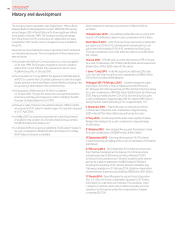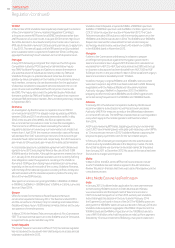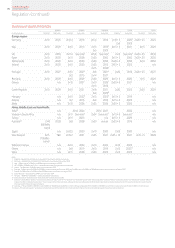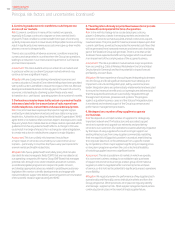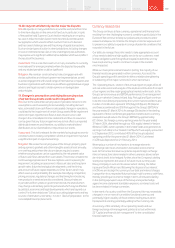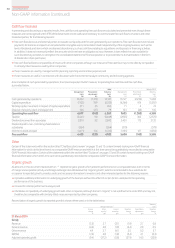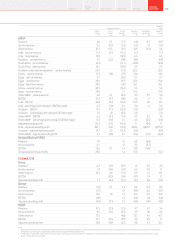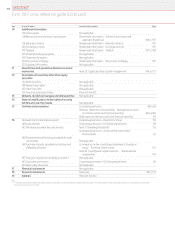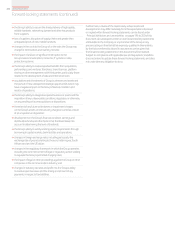Vodafone 2014 Annual Report Download - page 202
Download and view the complete annual report
Please find page 202 of the 2014 Vodafone annual report below. You can navigate through the pages in the report by either clicking on the pages listed below, or by using the keyword search tool below to find specific information within the annual report.
Risk of change in carrying amount of assets and liabilities
The main potential short-term nancial statement impact of the current
economic uncertainties is the potential impairment of non-nancial and
nancial assets.
We have signicant amounts of goodwill, other intangible assets and
plant, property and equipment allocated to, or held by, companies
operating in the Eurozone.
We have performed impairment testing for each country in Europe
as at 31 March 2014 and identified aggregate impairment charges
of £6.6 billion in relation to Vodafone Germany, Spain, Portugal, Czech
Republic and Romania. See note 4 “Impairment losses” to the consolidated
financial statements for further detail on this exercise, together with the
sensitivity of the results to reasonably possible adverse assumptions.
Our operating companies in Italy, Ireland, Greece, Portugal and Spain have
billed and unbilled trade receivables totalling £2.1 billion. IFRS contains
specific requirements for impairment assessments of financial assets.
We have a range of credit exposures and provisions for doubtful debts that
are generally made by reference to consistently applied methodologies
overlaid with judgements determined on a case-by-case basis reflecting
the specific facts and circumstances of the receivable. See note 23 “Capital
and financial risk management” to the consolidated financial statements
for detailed disclosures on provisions against loans and receivables as well
as disclosures about any loans and receivables that are past due at the end
of the period, concentrations of risk and credit risk more generally.
Additional risk
The signicant areas of additional risk for the Group are investment risk,
particularly in relation to the management of the counterparties holding
our cash and liquid investments; trading risks primarily in relation
to procurement and related contractual matters; and business
continuity risks focused on cash management in the event of disruption
to banking systems.
Financial/investment risk: We remain focused on counterparty risk
management and in particular the protection and availability of cash
deposits and investments. We carefully manage counterparty limits
with nancial institutions holding the Group’s liquid investments and
maintain a signicant proportion of liquid investments in sterling and
US dollar denominated holdings. Our policies require cash sweep
arrangements, to ensure no operating company has more than
€5 million on deposit on any one day. Further, we have had collateral
support agreements in place for a number of years, with a signicant
number of counterparties, to pass collateral to the Group under certain
circumstances. We have a net £1,055 million of collateral assets in our
statement of nancial position at 31 March 2014. For further details
see note 13 “Other investments” and note 23 “Capital and nancial risk
management” to the consolidated nancial statements.
Trading risks: We continue to monitor and assess the structure of certain
procurement contracts to place the Group in a better position in the
event of the exit of a country from the Eurozone.
Business continuity risks: Key business continuity priorities are focused
on planning to facilitate migration to a more cash-based business model
in the event banking systems are frozen, developing dual currency
capability in contract customer billing systems or ensuring the ability
to move these contract customers to prepaid methods of billing,
and the consequential impacts to tariff structures. We also have in place
contingency plans with key suppliers that would assist us to continue
to support our network infrastructure, retail operations and employees.
We continue to maintain appropriate levels of cash and short-term
investments in many currencies, with a carefully controlled group
of counterparties, to minimise the risks to the ongoing access to that
liquidity and therefore our ability to settle debts as they become due.
For further details see “Capital and nancial risk management” in note
23 to the consolidated nancial statements.
Going concern
The Group believes it adequately manages or mitigates its solvency and
liquidity risks through two primary processes, described below.
Business planning process and performance management
The Group’s forecasting and planning cycle consists of three in year
forecasts, a budget and a long range plan. These cycles all consist
of a bottom up process whereby the Group’s operating companies
submit income statement, cash ow and net debt projections. These are
then consolidated and the results assessed by Group management and
the Board.
Each forecast is compared with prior forecasts and actual results
so as to identify variances and understand the drivers of the changes
and their future impact so as to allow management to take action where
appropriate. Additional analysis is undertaken to review and sense check
the key assumptions underpinning the forecasts as well as stress-testing
the results through sensitivity analysis.
Cash ow and liquidity reviews
The business planning process provides outputs for detailed cash ow
and liquidity reviews, to ensure that the Group maintains adequate
liquidity throughout the forecast periods. The prime output is a two year
liquidity forecast which is prepared and updated on a daily basis which
highlights the extent of the Group’s liquidity based on controlled cash
ows and the headroom under the Group’s undrawn revolving credit
facility (‘RCF’).
The key inputs into this forecast are:
a free cash ow forecasts, with the rst three months inputs being
sourced directly from the operating companies (analysed on a daily
basis), with information beyond this taken from the latest forecast/
budget cycle;
a bond and other debt maturities; and
a expectations for shareholder returns, spectrum auctions and
M&A activity.
The liquidity forecast shows two scenarios assuming either maturing
commercial paper is renanced or no new commercial paper issuance.
The liquidity forecast is reviewed by the Group CFO and included in each
of his reports to the Board.
In addition, the Group continues to manage its foreign exchange and
interest rate risks within the framework of policies and guidelines
authorised and reviewed by the Board, with oversight provided by the
Treasury Risk Committee.
Vodafone Group Plc
Annual Report 2014200
Principal risk factors and uncertainties (continued)


